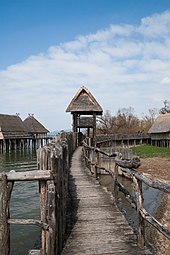History of construction: Difference between revisions
Aspect of history
The history of construction traces the changes in building tools, methods, techniques and systems used in the field of construction. It explains the evolution of how humans created shelter and other structures that comprises the entire built environment. It covers several fields including structural engineering, civil engineering, city growth and population growth, which are relatives to branches of technology, science, history, and architecture. The fields allow both modern and ancient construction to be analyzed, as well as the structures, building materials, and tools used.
Construction is an ancient human activity that began at around 4000 BC as a response to human’s need for shelter.[1] It has evolved and undergone different trends over time, marked by a few key principles: durability of the materials used, increase in building height and span, the degree of control exercised over the interior environment, and finally, the energy available for the construction process.[2]
Prehistoric Era[edit]
Stone Age[edit]
Humans during the Paleolithic era were hunter-gatherers. Their nomadic lifestyle led to temporary and short-lived buildings leading to a lack of surviving evidences of construction. However, it is believed that the earliest evidence of construction in the world is the 1.8 million year-old stone circle found at Olduvai Gorge representing the remains of a windbreak.[3]
By the mesolithic era, humans started to develop agriculture.[4] Hunter-gatherers built temporary shelter for hunters who would ambush their prey. Currently, the first evidence of man-made shelter dates back to 400,000 B.C. in Terra Amata, France which served as housing for hunters. [5]
Neolithic Era[edit]
By the Neolithic era, also known as the New Stone Age, humans developed agriculture and started to cultivate plants and domesticate animals. This change from the nomadic lifstyle meant that humans started building walls and forming cities [6]. In addition to living in caves and using rock shelters, the first buildings were simple tents, like the Inuit’s tupiq, and huts. Huts were built as protection from the elements like pit-houses, and as fortifications for safety like crannog.
Their shelters were built self-sufficiently by their inhabitants rather than by specialist builders, using locally available materials and traditional designs and methods. Because of this, what little can be said about very early construction is mostly conjecture and based on vernacular architecture or what is known about the way nomadic hunter-gatherers and herdsmen in remote areas build shelters today. For example, the first bridges made by humans were probably simple wooden logs placed across a stream and later on evolved into timber trackways.
Building materials and tools[edit]

Pre-historic men made tools out of bone, ivory, antler, hide, stone, wood, grass, metals (gold, copper and silver) and animal fibers. Various tools for cutting (hand axe, chopper, adze and celt), scrape or chop (flake tool), and tools to pound, pierce, roll, pull and lever were made and used. As building materials, they used bones such as mammoth ribs, hide, stone, metal, bark, bamboo, and animal dung.
Pre-historic men also used bricks and lime plaster as building materials.[7] For example, mud bricks and clay mortar dated to 9000 BC were found in Jericho. These mudbricks were formed with the hands rather than wooden moulds and herringbone pattern were made by the brick-maker’s thumbs.[8]
Building Techniques[edit]
The absence of metal tools placed limitations on the materials that could be worked, but it was still possible to build quite elaborate stone structures with ingenuity using dry stone walling techniques such as at Skara Brae in Scotland, Europe’s most complete Neolithic village. Another example of a settlement built in the neolithic is the Göbekli Tepe. It is made with T-shaped limestone pillars carved out using flint points and other rock-cut architecture methods.[9] The corbelled roof of Newgrange (c. 3,200 BC) shows that corbel archs were used since the neolithic age.[10][11]
One of the largest structures of this period was the Neolithic long house. It was a long, narrow timber dwelling built by the first farmers in Europe at least as early as 5000 to 6000 BC. Like all timber-framed and log structures (stilt houses) in early cultures, only the very lowest parts of the walls and post holes are unearthed in archaeological excavations; making reconstruction of the upper parts of these buildings largely conjectural.

The most remarkable Neolithic structure in Western…
Read More: History of construction: Difference between revisions

